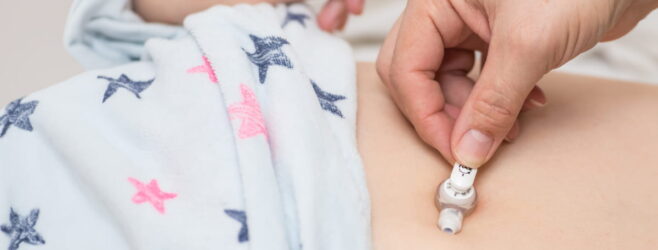Children living with a birth injury may have difficulty feeding themselves and require a feeding tube, which increases the risk of dehydration. Regularly monitoring your child’s hydration levels and consulting with their health care provider can help prevent problems. Learn more about how to ensure your child is getting enough water.
What Is an Enteral Feeding Tube?
An enteral feeding tube, also known as tube feeding, is a flexible plastic tube that delivers liquid food, fluids, and sometimes medications through the nose or directly into the stomach or small intestine.
Feeding tubes require powdered formula mixed with liquids. There are several different types of feeding tubes available depending on specific needs.
Here are 5 types of feeding tubes in the stomach:
- Standard gastrostomy tubes (G-tubes): Inserted directly into the stomach through a small incision in the abdomen, suitable for long-term feeding needs
- Percutaneous endoscopic gastrostomy (PEG) tubes: A type of G-tube placed with a small incision in the abdomen, often used in patients who cannot swallow safely
- Low-profile gastrostomy tubes (buttons): Sits flush against the skin, making it less noticeable and ideal for active children
- Non-balloon buttons: Similar to low-profile buttons but without an internal balloon, often used for long-term feeding when balloon buttons are not suitable
- Jejunostomy tubes (J-tubes): Inserted into the jejunum (part of the small intestine) and used for patients who cannot tolerate feeding directly into the stomach
The type of feeding tube your child requires depends on their unique needs. Factors include their medical condition, how well they can handle different feeding methods, and whether they need long-term or short-term nutritional support.
Feeding tubes and related medical care can be expensive. If your child’s health condition can be linked to medical negligence, you may be eligible for financial assistance. Contact us right now to see if we can help.
The Risk of Dehydration With Feeding Tubes
Individuals with enteral feeding tubes need to stay hydrated with fluids administered directly through their tubes.
Hydration is a critical factor with a feeding tube, but it is often overlooked since feeding tubes primarily focus on caloric intake. This can put children with enteral feeding tubes at a higher risk of dehydration.
Staying hydrated impacts overall health. Water provides bodies with essential vitamins and nutrients that help us function.
Additionally, water regulates overall body temperature and keeps joints, tissues, and muscles moist to help with movement.
Because of these factors, it’s essential for parents and caregivers to ensure proper hydration when managing enteral tube feeding.
Hydration in Children With Cerebral Palsy
Children with cerebral palsy (CP) often have difficulties using their mouth, throat, and neck muscles. They may also be unable to effectively communicate their thirst, further increasing their risk of dehydration.
Additionally, some medications that treat cerebral palsy can affect your child’s vitamin intake. For example, seizure medications may decrease the absorption of vitamins D, K, B6, B12, and C.
Keeping hydrated and replacing lost vitamins and nutrients is essential in maintaining hydration in enteral tube feeding.
It’s especially important for children with CP to get adequate water intake to hydrate and loosen tight muscles.
Can You Drink Water With a Feeding Tube?
Children with feeding tubes can usually drink water by mouth if their doctor allows it. However, they generally receive water through the tube.
For example, with PEG tube feeding, water is administered directly through the tube to maintain proper hydration.
Some parents may choose to skip pre-packaged feeding tube formulas and prepare their own blended foods for their child. Incorporating foods with high water content can help your child stay hydrated.
Foods with a high water content include:
- Cauliflower
- Celery
- Cucumbers
- Iceberg lettuce
- Strawberries
- Watermelon
- Zucchini
Your child’s doctor will give you detailed instructions on how much water through a PEG tube is needed to keep your child healthy and hydrated.
How Much Water Does My Child Need?
The specific amount of water your child needs can vary based on factors like their weight, climate, and individual medical conditions.
Generally, the American Academy of Pediatrics (AAP) and other medical guidelines suggest the following:
- For children up to 22 pounds: About 1.5 ounces of water per pound per day
- For children between 22 to 44 pounds: Around 34 ounces plus an additional 0.5 ounces per pound for any weight over 22 pounds
- For children over 44 pounds: Approximately 51 ounces plus an additional 0.25 ounces per pound for any weight over 44 pounds
If your child uses one, giving water through the PEG tube ensures they receive the necessary hydration safely and effectively.
When considering tube feeding water requirements for your child, consult with their pediatrician to determine the precise amount needed.
This will help ensure they stay adequately hydrated without overloading their system.
Symptoms of Dehydration to Watch for
Dehydration can be a significant concern, especially for children who may not be able to communicate their thirst effectively. Monitoring for dehydration is crucial.
To determine if your child is getting enough water, look for signs of dehydration.
Dehydration symptoms include:
- Changes in urine — dark yellow color, strong smell, decreased amounts
- Constipation
- Dry membranes in the mouth
- Irritability, restlessness, lethargy
- No tears when the child is crying
- Sunken eyes
If you notice any of these symptoms, it’s important to talk to your child’s doctor to ensure they are receiving proper hydration through their feeding tube.
Recognizing signs of dehydration in your child early can help prevent more serious complications.
Cerebral Palsy Feeding Tube Cleaning and Maintenance
An important part of maintaining hydration in enteral tube feeding is flushing. Regularly flushing your child’s feeding tube with water can help prevent clogging.
Flushing the enteral feeding tube is also important because it gives your child an extra dose of water.
The type of water used to flush your child’s feeding tube can vary by their specific needs.
Options include:
- Tap water: Use when flushing a gastrostomy tube. Tap water is safe to use for most enteral feeding tube patients unless specified otherwise.
- Purified water: Use when flushing a jejunostomy tube, mixing powder formula, diluting medications, or if your child has a weakened immune system.
Flush the feeding tube before and after every use to ensure that all food, formula, and medications are cleared from the tube and can enter your child’s system.
Financial Assistance and Support
Enteral feeding tubes and other accommodations can be expensive. One study found that using a feeding tube device costs over $50,000 per year in today’s dollars.
These expenses, combined with the cost of other cerebral palsy treatments, can be overwhelming for families.
In some cases, parents may be entitled to financial aid to help, particularly if medical errors caused their child’s condition. Birth injury lawsuits often result in substantial settlements, with the average payout being $1 million.
This money can provide financial relief for families, helping to cover the costs of medical treatments, therapies, and more to ensure children can live their best possible lives.
Call our patient advocates at (800) 914-1562 right now to see if we can connect you with legal help.



